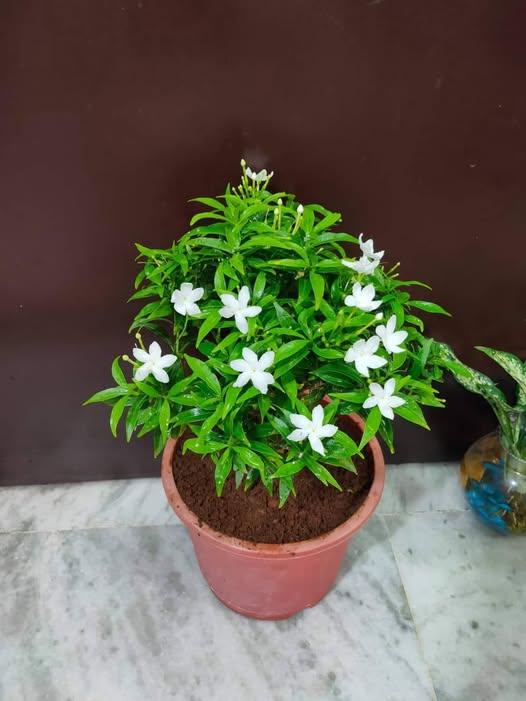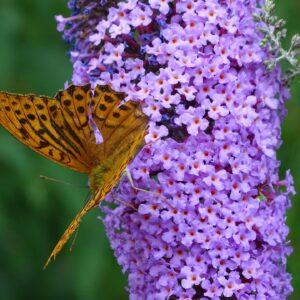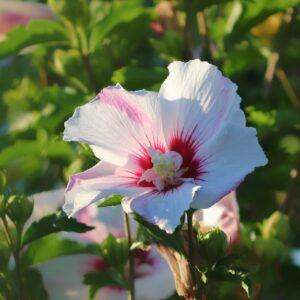“🌼🌿 Pinwheel Flower (Chandni Plant) – The Evergreen Beauty
The Pinwheel Flower, also referred to as Chandni or Tagar in India and Pakistan, is an evergreen shrub characterized by its graceful white blooms that resemble pinwheels. These flowers emit a pleasant fragrance and typically bloom throughout the year in warmer climates. The plant’s vibrant green foliage makes it a favored option for hedges, flower beds, and container gardening.
Indigenous to South and Southeast Asia, the Chandni plant represents purity and tranquility, frequently found in temple gardens, courtyards, and urban settings.
🌸 General Description
Botanical name: Tabernaemontana divaricata
Common names: Chandni, Tagar, Pinwheel Flower, Crape Jasmine, East Indian Rosebay
Plant type: Evergreen shrub or small tree
Height: 3–8 feet (may exceed this height if not pruned)
Spread: 2–5 feet
Leaves: Glossy, deep green, oval-shaped with pointed tips
Flowers: White, five-petaled, pinwheel-shaped; can be single or double form
Fragrance: Mild and sweet
Blooming season: Spring to late fall (year-round in warmer regions)
☀️ Light and Temperature Requirements
Sunlight:
Thrives in full sun to partial shade
Ideal: 4–6 hours of sunlight daily
Optional second feeding in mid-summer
Adding compost or organic mulch around the base contributes to long-term nutrition.
⚠️ Avoid fertilizing in late fall, as it may promote tender growth that is susceptible to winter damage.
✂️ Pruning and Shaping
Boxwood is recognized for its ability to be sheared and is a preferred choice for shaping.
When to prune:
Light pruning can be performed at any time.
Major pruning and shaping should occur from late spring to early summer.
How to prune:
Utilize hedge shears or clippers for shaping.
Eliminate any dead or diseased branches.
Occasionally thin out the interior to enhance airflow.
✂️ Tip: Prune on cloudy days to prevent sun scorch on exposed inner leaves.
🌿 Propagation Methods
Semi-hardwood Cuttings:
Take cuttings of 4–6 inches in length during late summer.
Remove the lower leaves and dip the cuttings in rooting hormone.
Plant in a moist potting mix and cover with plastic to maintain humidity.
Roots will develop in 4–6 weeks.
Air layering or division is less frequently used.
🌱 Boxwood propagation is a slow but rewarding process, particularly for heirloom varieties.
🐛 Pests and Diseases
Although hardy, Boxwood may face several challenges:
Pests:
Boxwood leafminer (tiny fly larvae)
Boxwood mites
Aphids or scale (rare)
Diseases:
Root rot (caused by overwatering or inadequate drainage)
Boxwood blight (a serious fungal infection)
Leaf scorch (resulting from extreme sun or wind)
🛡️ Solutions:
Water at the soil level.
Refrain from overhead watering.
Space plants adequately for air circulation.
Apply neem oil or insecticidal soap as necessary.
🎍 Garden and Landscape Uses
Formal hedges or garden borders.
Topiary art (shapes such as balls, spirals, and pyramids).
Foundation plantings.
Pathway edges.
Potted decorations for entrances and patios.
🌿 Complements beautifully with lavender, roses, camellias, or herbs in traditional gardens.
✅ Conclusion
Boxwood is a classic favorite for good reason—its ease of shaping, versatility, and evergreen nature provide structure, elegance, and low-maintenance greenery to your garden throughout the year. Whether utilized in a formal arrangement or a container garden, its adaptability renders it a dependable and gratifying plant.
In extremely hot climates, light afternoon shade is advantageous
Temperature:
Ideal range: 20–35°C (68–95°F)
Not frost-tolerant—provide protection during cold spells below 10°C (50°F)
Suitable for tropical and subtropical climates
💡 Can be cultivated indoors in containers near sunny windows in cooler climates.
💧 Watering Routine
Chandni prefers soil that is moderately moist and requires regular watering.
Young plants:
Water three times a week to promote root development
Mature plants:
Water twice a week during summer; reduce frequency in winter or rainy seasons
Soil should remain moist but not saturated
🪴 Check the top 1–2 inches of soil—if it feels dry, it is time to water.
Mulching aids in moisture retention and weed suppression.
🌱 Soil and Fertilizer Needs
Soil:
Prefers well-draining loamy or sandy soil
pH: Slightly acidic to neutral (6.0–7.0)
Enhance soil quality with organic compost, cow dung, or leaf mold
Fertilizer:
Use balanced fertilizer to support growth.”





Reviews
There are no reviews yet.